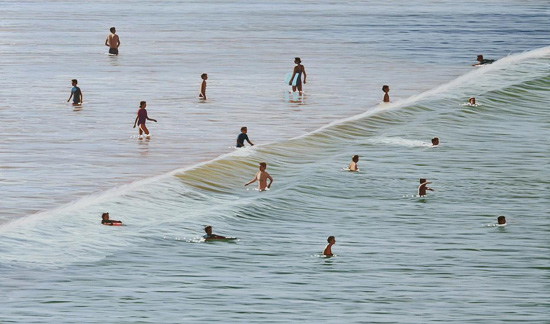From Andrew Frost…
If there was just one identifiable trend happening in painting in Sydney in 2015 then it’d have to be the seemingly endless variations produced by young artists on the limited tropes of hard edge, minimalist and geometric abstraction. Every other week there’s an invitation to an exhibition to see work that ‘re-interrogates’ some well worn influences. In that context, the painter Paul Haggith has an unusual claim: citing the influences of the abstract spatiality of Jackson Pollock‘s spatter universe and the hard edge realism of William Dellafield Cook, Haggith says he is “…an abstract painter playing with colour and shapes that happen to be realist.” It’s a remarkable thing that so few artists make a claim that they’re approaching abstraction from the position of realism, so any such suggestion is at least a curiosity.
In his show Luminescence at CK Gallery, Haggith – a finalist in 2014 of no fewer than three prizes [The Sulman Prize, The Mosman Art Prize and the Gosford Art Prize] – presents a series of familiar seaside and beach scenes, little vignettes of summer beach and waterside life painted in oils. Haggish’s treatment renders the edges of things seen as hard and definite, a graphic treatment that he extends into experiments with pictures created using an iPad, while the whites and blacks are solid and unforgiving. While the subjects of the pictures purposely edge toward the banal, it’s this idea that abstraction lurks within the realist treatment that’s intriguing. Haggis asks us to contemplate the shapes and coincidences of the compositions as swathes of colour and line and to doubt the veracity of the image – it’s here, in the transformation of the banal into the remarkable, that the pictures really take off.
Until April 26
CK Gallery, Newtown
Pic: Paul Haggith, The Bathers, 2015. Oil on linen, 99x153cms.


“It’s a remarkable thing that so few artists make a claim that they’re approaching abstraction from the position of realism” is an odd thing to say when many abstract artists refer to a reductive approach to realism in the early 20th century. This is the reductive approach to abstraction and Laurence Cahoone’s Modernism to Postmodernism: An Anthology has many instances as does Harrison and Wood’s Art in Theory, 1900-2010. The reductive approach to expressionist and to a lesser extent, formalist abstraction from figurative drawing was a commonplace in the art schools in the 1960s.
I forgot – the two primary examples of reductive abstraction in painting, despite what has been said about them in art history are Kandinsky and Lissitzky.
Thanks ‘Zara’ – both good points but you’re overlooking the statement in the post about the context of this work – it wasn’t that an abstraction derived from the figurative is unprecedented but how, in the context of what’s happening in Sydney 2015, this work goes against the grain in its fidelity to figuration while claiming to be ‘abstract’ – Art Life Management